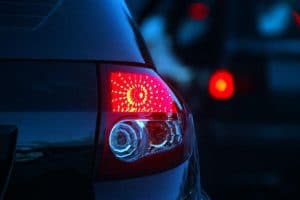Turn Signals: A Common Cause for DWI Stops
 One of the most common bases for a traffic stop leading a DWI arrest is failure to use a signal. While it is a relatively minor offense, keep in mind that police only need a single reason, no matter how minor, to have reasonable suspicion to make a stop. Reasonable suspicion requires articulable facts that indicate that a person is, was, or will be involved in criminal activity. Though small, traffic violations are still “criminal activity” for purposes of making DWI stops.
One of the most common bases for a traffic stop leading a DWI arrest is failure to use a signal. While it is a relatively minor offense, keep in mind that police only need a single reason, no matter how minor, to have reasonable suspicion to make a stop. Reasonable suspicion requires articulable facts that indicate that a person is, was, or will be involved in criminal activity. Though small, traffic violations are still “criminal activity” for purposes of making DWI stops.
Turn Signal Statute
The statute regarding turn signals is Transportation Code section 545.104. That statute states:
(a) An operator shall use [a signal] . . . to indicate an intention to turn, change lanes, or start from a stopped position.
(b) An operator intending to turn a vehicle right or left shall signal continuously for not less than the last 100 feet of movement of the vehicle before the turn.
Subsection (c), while still important, is not as commonly mentioned. That subsection says that drivers cannot use turn signals as a “do pass” signal to other drivers.
Breaking down the Turn Signal Statute
The statute is short and sweet. It is also somewhat easy to understand. However, pay very close attention to the bold and italicized words. First, the person must “intend” to turn or change lanes for the statute to apply. For example, police shouldn’t be able to stop you for this “violation” if you suddenly have to swerve to avoid something in the road. While there is still some “intent” to turn or change lanes (i.e., you “intend” to move away from the obstacle), there likely would not be enough legal intent.
Second, subsection (a) specifically states three situations requiring use of a turn signal. The most important two for most stops are turns and lane changes. Notice how they are completely separate actions and not lumped into just “turns”. This is important for the third point.
Third, subsection (b) establishes a 100 foot requirement for signalling an intent to turn. Unlike subsection (a), this subsection only mentions the word “turn”. In other words, the 100 foot requirement only applies to turns, NOT lane changes. There is no reason for the statute to treat the two as separate actions in one subsection only to generalize them both as “turns” for the other! This, however, has not stopped at least one court from holding that the 100 foot requirement also applies to lane changes. A good review of your DWI Video will show your DWI Lawyer whether the officer had reasonable suspicion to make the DWI stop or not.
More about Mimi Coffey & The Coffey Firm
When people look for a Top DWI Attorney or Best DWI Attorney, they look for experience, certification, and respect in the legal community. Mimi Coffey is a nationally-renowned trial attorney, board-certified in DWI by the NCDD. She has been practicing for over 24 years and is an author of multiple DWI Defense textbooks. She is also a national and state-wide lecturer on the law.
The Coffey Firm handles a wide variety of cases, including Unlawful Carrying Weapon (UCW), Assault (including family violence), and Possession charges. We can also help you try to seal your record or avoid probation revocation.
Mimi is also listed on several “top criminal lawyer near me” directory listings such as DWI Lawyers for Wise County, DWI Lawyer Tarrant County, DWI attorney Dallas County, DWI attorneys Collin County and DWI attorneys Parker County. Mimi is a caring DWI Lawyer in DFW, She is also involved in the Texas Tech School of Law foundation and enjoys using the skills she has developed to give back to the community.

